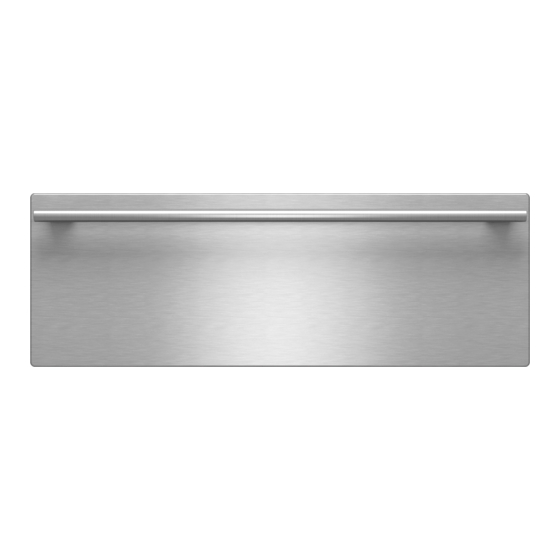
Wolf WWD30 Troubleshooting Manual
Hide thumbs
Also See for WWD30:
- Installation instructions manual (20 pages) ,
- Installation manual (20 pages) ,
- Use & care information manual (16 pages)
Table of Contents
Advertisement
Quick Links
Previous Page
Troubleshooting Guide
TROUBLESHOOTING GUIDES
This section of the manual contains the General Troubleshooting Guide which will help the Service Technician trou-
bleshoot a Wolf WWD30 unit. Following the General Troubleshooting Guide is the Electronic Control System Test
Procedures to be performed after going through the General Troubleshooting Guide and determining that the elec-
tronic control system is suspect.
How to Use the General Troubleshooting Guide
The Table of Contents below indicate how the General Trouble Shooting Guide on the following pages is arranged.
Locate the description of the problem that the unit is experiencing from the Table of Contents, below. To the left of
the problem description in the Table of Contents is a letter. On the page indicated, locate that letter in the left col-
umn of the General Troubleshooting Guide. The center column of the General Troubleshooting Guide will identify
the possible causes for the problem. The information in the right column of the General Troubleshooting Guide will
explain what tests to perform and/or what action to take to correct the problem.
Before continuing, take note of the WARNINGS and CAUTIONS at the bottom of this page.
General Troubleshooting Guide Table of Contents
Error Codes Troubleshooting Guide .............................................................................................................................................. 5-3
A.
Unit does not function at all ................................................................................................................................................... 5-4
B.
No Heat at Any or All Settings ............................................................................................................................................... 5-4
C. No Heat At Proof Setting Only ........................................................................................................................................... 5-4
D. Excessive Heat At Any Or All Settings .................................................................................................................................... 5-4
E.
Excessive Condensation in Drawer ....................................................................................................................................... 5-4
F.
Food Dries Out ...................................................................................................................................................................... 5-5
G.
One or more LCD (ON/OFF indicator, Temp. Range Indicator or segment(s) of Temp. Readout) does not illuminate ....... 5-5
H. LCD is black ........................................................................................................................................................................... 5-5
I.
One or more LCD (ON/OFF indicator, Temp. Range Indicator or segment(s) of Temp. Readout) illuminated Constantly .. 5-5
J.
Drawer Does Not Slide Smoothly .......................................................................................................................................... 5-5
K.
Drawer Does Not "Pull In"........................................................................................................................................................ 5-5
-
IF REMOVING A WARMING DRAWER FROM ITS INSTALLATION FOR TROUBLESHOOTING PURPOSES, REMEMBER
THAT THE UNIT IS HEAVY AND COULD TIP AND/OR FALL WHEN PULLED FORWARD BEYOND THE ANTI-TIP COM-
PONENTS, RESULTING IN SERIOUS INJURY OR DEATH.
-
TO AVOID ELECTRIC SHOCK, POWER TO THE UNIT MUST BE DISCONNECTED WHENEVER ACCESSING AND/OR
REMOVING COMPONENTS POWERED BY ELECTRICITY OR COMPONENTS NEAR OTHER ELECTRICAL COMPO-
NENTS. IF THE UNIT IS PLUGGED IN, BUT HAS NOT BEEN SWITCHED ON BY PRESSING THE UNIT ON/OFF KEY,
115 VOLTS AC IS STILL PRESENT AT THE POWER BOARD.
-
Metal edges may be sharp. Use caution when servicing unit to avoid personal injury.
-
The heating element can get very hot. To avoid personal injury use caution when servicing the unit,
making sure the heater has cooled before working on or around it.
-
If accessing components under the shell, the insulation must be properly reinstalled and positioned.
Failure to do so may lead to damage to the surrounding cabinetry.
-
Low voltage is used for most electronic control components. To avoid damaging the appliance, do NOT
apply 115V AC to electronic control components.
Previous Page
Main Menu
WARMING DRAWER WWD30
5-2
Main Menu
WWD30 Menu
WWD30 Menu
Next Page
Page #
Next Page
Advertisement
Table of Contents

Summary of Contents for Wolf WWD30
- Page 1 This section of the manual contains the General Troubleshooting Guide which will help the Service Technician trou- bleshoot a Wolf WWD30 unit. Following the General Troubleshooting Guide is the Electronic Control System Test Procedures to be performed after going through the General Troubleshooting Guide and determining that the elec- tronic control system is suspect.
- Page 2 Previous Page Previous Page WWD30 Menu Next Page Main Menu WARMING DRAWER WWD30 Troubleshooting Guide ERROR CODE TROUBLESHOOTING GUIDE: ERROR CODE CAUSE TEST / ACTION Incorrect checksum Replace Control Board (Invalid Checksum Error) In FSM (Field Service Mode), view temper- Temperature >300ºF...
- Page 3 Previous Page Previous Page WWD30 Menu Next Page Main Menu WARMING DRAWER WWD30 Troubleshooting Guide General Troubleshooting Guide PROBLEM POSSIBLE CAUSE TEST / ACTION Check power to unit. Plug unit in, switch supply A. Unit Does Not Function at All...
- Page 4 Drawer Glides Defective Remove drawer tub and inspect glide operation. Replace if defective. Self-Close Feature Broken Replace Slide. (Wolf Recommends to replace K. Drawer Does Not “Pull In” ALL slides at same time) Slide Mounting Screw is Loose Tighten or Replace Screw...












Need help?
Do you have a question about the WWD30 and is the answer not in the manual?
Questions and answers